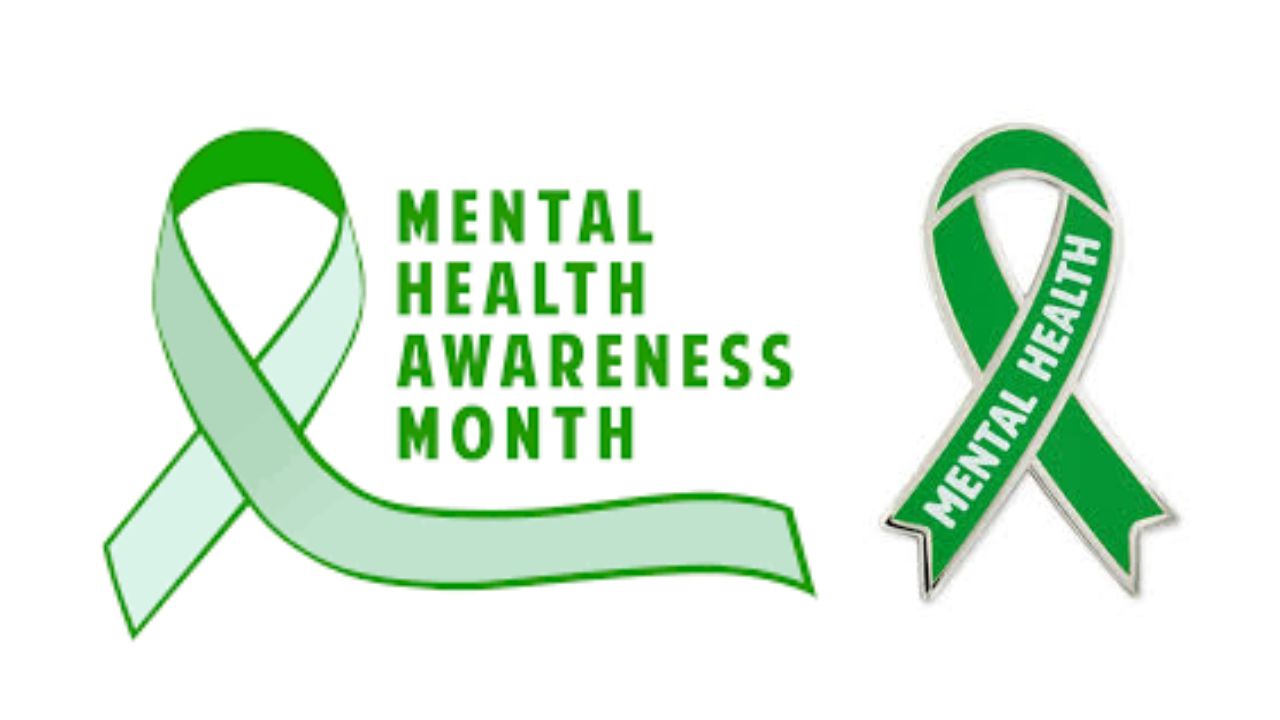The color for Mental Health Awareness Month color is green, symbolizing hope, support, and mental health advocacy. Individuals and organizations worldwide raise awareness about mental health and promote positive well-being in May.
This observance aims to reduce stigma, educate the public, and provide resources for those in need. Through various activities and events, Mental Health Awareness Month encourages open conversations and emphasizes the importance of mental health care. People support those affected by mental health conditions by wearing green and participating in awareness campaigns.
Let’s join together to spread awareness, support, and promote mental health wellness during this important month.

Credit: www.pinterest.com
The Significance Of Color In Mental Health Awareness
As May marks Mental Health Awareness Month, it is essential to acknowledge how color plays a significant role in bringing awareness to mental health issues. Color has been used to represent different emotions, moods, and feelings. Therefore, understanding the significance of colors in mental health awareness is vital. This article will explore the Symbolic Meanings of Colors and Color Psychology and Emotions.
Symbolic Meanings Of Colors
Colors have been used symbolically to represent different emotions, moods, and feelings. Here are some symbolic meanings of colors used in mental health awareness:
| Color | Symbolic Meaning |
|---|---|
| Green | Represents growth, harmony, and renewal. |
| Yellow | Represents happiness, optimism, and hope. |
| Blue | Represents calmness, serenity, and trust. |
| Purple | Represents spirituality, creativity, and luxury. |
| Orange | Represents enthusiasm, warmth, and energy. |
Color Psychology And Emotions
The study of how colors influence human behavior and emotions is known as color psychology. The following colors correspond with the following feelings:
- Red: Associated with passion, love, and anger. Red is known to increase heart rate and blood pressure.
- Yellow: Associated with happiness, optimism, and warmth. Yellow is known to stimulate mental activity.
- Green: Associated with growth, harmony, and balance. It is well known that the color green is relaxing.
- Blue: Associated with calmness, serenity, and trust. Blue is known to lower blood pressure and heart rate.
- Purple: Associated with creativity, spirituality, and luxury. Purple is known to stimulate imagination and creativity.
Understanding the significance of colors in mental health awareness is crucial as it helps to create awareness and promote positive mental health. Different colors can evoke various emotions and moods, and choosing the right color to represent the intended message is essential.
Mental Health Awareness Month Color: A Brief History
Origins And Evolution
Mental Health Awareness Month began in the United States in 1949 and was led by Mental Health America.
Global Impact And Recognition
Over time, other countries adopted May as Mental Health Awareness Month, expanding its reach and importance worldwide.
Green Ribbon: A Beacon Of Hope
Mental Health Awareness Month uses the color green to symbolize hope and support for individuals struggling with mental health issues. The green ribbon serves as a beacon of hope, representing the solidarity and compassion of the community toward those facing mental health challenges.
Adoption Of The Green Ribbon
The adoption of the green ribbon as a symbol of mental health awareness dates back to the early 2000s. It was chosen for its association with growth, harmony, and renewal, reflecting the journey toward mental wellness. The green ribbon has since become a widely recognized emblem, fostering awareness and understanding.
Green Ribbon Campaigns Worldwide
Communities worldwide have embraced the green ribbon as a powerful emblem of mental health advocacy. Green ribbon campaigns have been launched to raise awareness, reduce stigma, and promote access to mental health resources. From local initiatives to global movements, these campaigns aim to foster empathy and support for individuals facing mental health challenges.
Colors Beyond Green: Other Symbols Of Support
Mental Health Awareness Month brings attention to the significance of mental well-being. It encourages using various symbols and colors to support those affected by mental health issues. While the color green has been widely recognized as the symbolic color for mental health awareness, other colors and personal stories play a vital role in this movement.
Variety Of Colors Used
Several colors have been adopted to represent different aspects of mental health awareness. Purple, for instance, has been associated with the campaign against suicide and self-harm, while silver represents the importance of providing support to individuals struggling with mental health challenges. These colors, along with others, broaden the visual representation of mental health awareness beyond the traditional green.
Personal Stories And Color Choices
Many individuals have chosen specific colors to represent their personal experiences with mental health. Some may choose a color that resonates with them deeply and personally, while others may select one that reflects their journey toward healing and resilience. These personal stories behind color choices add depth and significance to the diverse spectrum of colors associated with mental health awareness.
Educational Initiatives During Awareness Month
Mental Health Awareness Month is an opportunity to promote understanding and knowledge about mental health issues. Educational initiatives play a crucial role in raising awareness and reducing the stigma associated with mental health conditions. During this significant month, various academic activities and programs are organized to foster understanding and support for individuals with mental health challenges.
Promoting Knowledge And Understanding
Educational initiatives during Mental Health Awareness Month aim to promote knowledge and understanding about mental health. Through workshops, seminars, and online resources, individuals can gain insights into mental health conditions, treatment options, and coping strategies. These initiatives also focus on educating the public about the importance of mental well-being and the impact of supportive environments on mental health.
Community Events And Activities
Community engagement is vital in spreading awareness and fostering support for mental health. Local organizations often host events such as panel discussions, art exhibits, and informational sessions to engage the community in open conversations about mental health. These activities provide a platform for individuals to share experiences, learn from experts, and connect with others experiencing similar challenges.

Credit: www.freepik.com
Sharing Stories: The Power Of Personal Narratives
Sharing personal stories can have a profound impact on mental health awareness. By openly discussing our experiences, we break down barriers and create a sense of community. The power of personal narratives lies in their ability to foster empathy, understanding, and connection. This Mental Health Awareness Month, let’s explore the significance of sharing stories and how it can contribute to breaking the stigma surrounding mental health.
Breaking The Stigma
Breaking the stigma around mental health starts with individuals sharing their narratives. When we speak openly about our struggles, we challenge misconceptions and create a supportive environment. Personal stories humanize the experience of mental health and show that it is a universal concern. Breaking the stigma will pave the way for greater acceptance and understanding.
Encouraging Open Conversations
Encouraging open conversations about mental health is essential for fostering a supportive community. When individuals share their narratives, it encourages others to speak up and seek help. These conversations help normalize discussions about mental health and make it easier for individuals to reach out for support. Sharing stories creates an environment where open discussions are valued and encouraged.
Advocacy And Action: What Can We Do?
Donate to local organizations supporting mental health initiatives.
Participate in charity events and fundraisers for mental health awareness.
Volunteer your time to assist mental health organizations in their activities.
Promote laws that provide mental health resources and assistance top priority.
Write to your representatives urging them to prioritize mental health legislation.
Attend community meetings to voice your support for mental health initiatives.

Credit: www.istockphoto.com
Looking Ahead: The Future Of Mental Health Advocacy
Embracing the symbolic green ribbon for Mental Health Awareness Month signifies hope and support for those facing mental health challenges. Advocates are propelling the movement forward, nurturing a future where mental health is destigmatized and prioritized. Together, we paint a brighter tomorrow for mental health advocacy.
May is Mental Health Awareness Month, a necessary time to raise awareness about mental health issues and advocate for those who are struggling with mental health challenges. As we look ahead to the future of mental health advocacy, it’s essential to consider the innovations in mental health care and the role of social media and technology in promoting mental wellness.
Innovations In Mental Health Care
In recent years, many exciting innovations in mental health care offer new hope and opportunities for struggling people. One promising area of research is the use of psychedelics, such as psilocybin and MDMA, to treat conditions like depression, anxiety, and PTSD. Studies have shown that these substances can have powerful therapeutic effects, helping patients to confront and overcome deep-seated emotional and psychological issues.
Another area of innovation is digital therapeutics, which uses software and other digital tools to deliver mental health interventions. Apps like Headspace and Calm, for example, offer guided meditation and mindfulness exercises that can help reduce stress and anxiety. Other apps use cognitive-behavioral therapy techniques to help users manage symptoms of depression and anxiety.
The Role Of Social Media And Technology
Social media and technology have also become increasingly crucial in mental health advocacy. Platforms like Twitter, Instagram, and TikTok have provided a space for people to share their mental health journeys, connect with others who are going through similar experiences, and advocate for better mental health care.
Mental health apps and online therapy platforms have also made it easier for people to access mental health care from the comfort of their own homes. Teletherapy, for example, allows patients to connect with mental health professionals via video chat, while text-based therapy platforms provide support and counseling through messaging apps.
As we look ahead to the future of mental health advocacy, it’s clear that many exciting developments are on the horizon. Whether through innovative new treatments, digital interventions, or social media platforms, we have more tools than ever to support those who are struggling with mental health challenges. By continuing to raise awareness and advocate for better mental health care, we can build a brighter future for all.
Frequently Asked Questions
What Is The Color For Mental Health Month?
The color for Mental Health Month is green. It symbolizes hope, support, and awareness. Green is used to promote mental health advocacy and reduce stigma.
Why Is Green The Color For Mental Health Awareness?
Green is the color for mental health awareness because it symbolizes hope, growth, and healing. It promotes positivity and wellbeing.
What Is The Color Of The Mental Day?
The color of the mental day is blue. Blue is known for promoting calmness and productivity.
What Are The Four Types Of Mental Health?
Anxiety disorders, mood disorders, psychotic disorders, and eating disorders are the four categories of mental illness.
Conclusion
As Mental Health Awareness Month approaches, let’s remember the significance of the color green. It symbolizes hope, growth, and resilience for those facing mental health challenges. We can create a more inclusive and understanding environment for all by spreading awareness and support.
Let’s continue the conversation and advocate for mental well-being throughout the year.

Hello there! I’m here to assist you with health tips and tricks. Whether you’re looking to boost your energy, improve your sleep, or enhance your overall well-being, I’m here to guide you with strategies and frameworks that can empower you to make positive changes.
First and foremost, it’s important to understand that health is a holistic concept encompassing various aspects of physical, mental, and emotional well-being.

